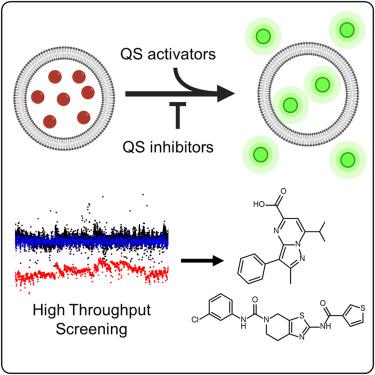Cell Chemical Biology ( IF 8.6 ) Pub Date : 2021-12-20 , DOI: 10.1016/j.chembiol.2021.12.005 Thomas J Polaske 1 , Curran G Gahan 2 , Kayleigh E Nyffeler 3 , David M Lynn 4 , Helen E Blackwell 1

|
Strategies to both monitor and block bacterial quorum sensing (QS), and thus associated infections, are of significant interest. We developed a straightforward assay to monitor biosurfactants and lytic agents produced by bacteria under the control of QS. The method is based on the lysis of synthetic lipid vesicles containing the environmentally sensitive fluorescent dye calcein. This assay allows for the in situ screening of compounds capable of altering biosurfactant production by bacteria, and thereby the identification of molecules that could potentially modulate QS pathways, and avoids the constraints of many of the cell-based assays in use today. Application of this assay in a high-throughput format revealed five molecules capable of blocking vesicle lysis by S. aureus. Two of these compounds were found to almost completely inhibit agr-based QS in S. aureus and represent the most potent small-molecule-derived QS inhibitors reported in this formidable pathogen.
中文翻译:

使用高通量脂质囊泡裂解法鉴定强烈抑制细菌群体感应的小分子
监测和阻断细菌群体感应 (QS) 以及相关感染的策略具有重要意义。我们开发了一种简单的检测方法来监测 QS 控制下细菌产生的生物表面活性剂和裂解剂。该方法基于含有对环境敏感的荧光染料钙黄绿素的合成脂质囊泡的裂解。该测定允许原位筛选能够改变细菌产生生物表面活性剂的化合物,从而鉴定可能调节 QS 途径的分子,并避免当今使用的许多基于细胞的测定的限制。以高通量形式应用该测定揭示了五种能够阻止金黄色葡萄球菌引起的囊泡裂解的分子。发现其中两种化合物几乎完全抑制金黄色葡萄球菌中基于agr的 QS ,代表了在这种可怕的病原体中报道的最有效的小分子衍生 QS 抑制剂。



























 京公网安备 11010802027423号
京公网安备 11010802027423号